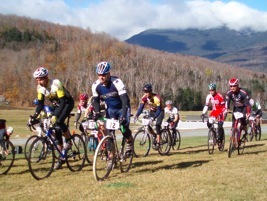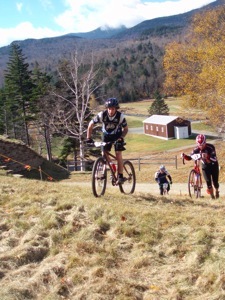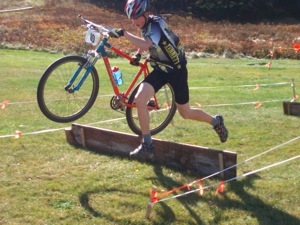November 2, 2009


By Marty Basch
Thinking of hanging the bicycle in the barn? Wrong.
It's cyclocross season across New England.
Think steeple chase for bicyclists. Some ride cyclocross specific bicycles. Others are on road bikes. There are those on mountain bikes. Tires are knobby.
They pedal on pavement, dirt, grass and gravel. There is mud, steep hills and barriers for them to jump over. They sometimes carry their bikes on their shoulders.
"This helps keep you off the indoor trainer," said Bartlett's mountain biking Joe Orsino before taking part in the season's first 'Cross in the Glen series, a three-race cyclocross series series held at Great Glen Trails at the base of Mount Washington.
Hard-packed trails, a tunnel under Route 16 and a taunting headwind at times were part of the competition which featured novices to elite riders.
Psychocross?
The name cyclocross, also called cyclecross, also is a clue as to how the discipline evolved—for cross-training. When the leaves fall, it can become a sedentary season before winter arrives. So reputed credit goes to the Europeans who invented cyclocross as a way to train during those dormant months.
Meg Skidmore of Randolph was one of the racers. A relative cyclocross rookie competing in her second race, she is an avid triathlete and bicyclist who loves racing.
"There are different challenges during the race," she said. "You are not just on your bike for the whole race. There is running and jumping. The idea is to have fun and not get discouraged."
Cyclists ride the course several times, allowing racers opportunities to try different approaches to strategy and obstacles. They'll find a line up a hill. They could trip on a barrier or have trouble clipping into and out from their riding shoes. They might decide to carry a bike a bit more during a section. Depending on the weather, mud, rain and snow are formidable challenges.
Change it up
Jackson's Bruce Diehl is a highly competitive road cyclist riding for Sunapee Continental Paving. During the road riding season, he is on the road, competing in races from 3-mile long time trials to 200-plus mile endurance events.
"I have a hard time letting go of summer," he says, returning to cyclocross for the first time in 13 years.
Diehl competes on a cyclocross bike. He says they are generally heavier than road bikes and are more durable. They have a higher clearance by the bottom bracket and have cantilever brakes instead of the side-pull caliper brakes. Generally, he says competitors use mountain bike shoes and mountain bike pedals, plus knobby tires.
"Courses tends to be very challenging," he says. "There is a lot of stuff in the way to break your rhythm. The idea is to break the riders' rhythm as much as possible."
The competitions are also spectator-friendly with the Great Glen course having cyclists ride various stretches near the base lodge before sending them out to pasture.
"The great thing about this is that it is a great spectator sport," said Orsino. "You can hear people yelling you on." Orsino was riding in his fourth cyclocross race.
There’s more in store
If you are really hardcore about cyclocross, head south in late November and early December to Massachusetts and Rhode Island for the Verge New England Championship Cyclocross Series . Bay State Cyclocross takes place November 28 and 29 in Sterling while the NBX Grand Prix is December 5 and 6 in Warwick, R.I.
Going to try? Then heed Orsino's advice: Don't get lapped.







